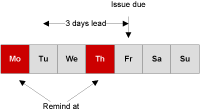Manage User Profile¶
You can set your personal configuration like password, username, profile picture, reminder emails, system role, and many more items.
To manage your user profile, click on your profile picture on the top right of the main menu bar.
Activate LDAP¶
It is possible to keep your access data like username and password on an LDAP compatible directory server. This way, you can use your Windows or Unix password to log in to Allegra.
Two-factor authentication¶
Two-factor authentication is either optional or must be used by all users by default, as set by the system administrator. The second factor can be either the user email or a common app, such as Microsoft or Google Authenticator.
Set color scheme¶
You can customize the appearance of the user interface to suit your needs. To do this, select a corresponding theme. For the theme “tpmaterial”, you can use one of the default color schemes or create your own.
Download behavior¶
Normally, the browser decides whether downloads are displayed directly in the browser window or whether a dialog box offers the possibility to save the download. Here you can set that downloads are always saved.
Set CSV separator¶
Allegra can export reports to Excel spreadsheets. Depending on the language settings of your Office installation, different separators are used (typically, comma or semicolon). Here you can set the character that matches your Office installation.
Query Layout Management¶
If you enable this item, Allegra will remember the layout you set in the Task Navigator for each filter you run. This includes which columns you had set, and also the sorting and grouping. This is usually the preferred behavior.
If this item is disabled, the respective default layout is used.
Set system role¶
Each user is assigned a system role. The system role determines which system authorizations a user has (for example, system administrator or normal user) and which menu elements and other objects on the user interface they can see. By assigning roles you can reduce the complexity of the user interface when users do not require the full range of functions.
As an administrator, you can configure the highest system role that each user can set for themselves.
Configure Email Reminders¶
Allegra can send you email reminders of items that are due soon or are already overdue. You can set the days of the week you want to receive reminders and how many days in advance you would like to be reminded.
Example:
Let’s say an item is due on Tuesday, April 24 and you have set your profile to only send reminders on Mondays. If you set the lead time to ten days, you will receive a reminder email on Monday, April 16. So, in the worst case scenario, you may receive the reminder only three days before the due date of the item.
The following figure illustrates the case where an item is due on Fridays, and reminders are only sent on Mondays and Thursdays. With a lead time of three days, the reminder is sent on Thursday.

Activate deputy¶
You can name a deputy in case you are not there. The deputy gets all rights and roles, both global and RACI roles, that you have. For example, if you are the manager of an item, your deputy will see that item as if they were the manager of it. However, any actions that your substitute takes will remain identifiable as theirs and will not be counted as yours.
Enable task styles¶
If you activate task styles, priorities, states, agents, and item types can be displayed with different foreground and background colors and text styles in the Task Navigator, depending on their value. For example, you can assign a red background color to items with a high priority, and a green background color to items with a low priority. In the taskboard, you can change the color of the first bar at the top of the cards. The setting of the colors is made system-wide by the system administrator.
Manage availability¶
You can specify on which days you are not available, e.g., because you are on holiday, ill, or travelling.
You can always specify your availability on the basis of a basic calendar, which includes general days off, such as weekends or public holidays. In your personal calendar, you can only manage absences or attendances that differ from the base calendar.